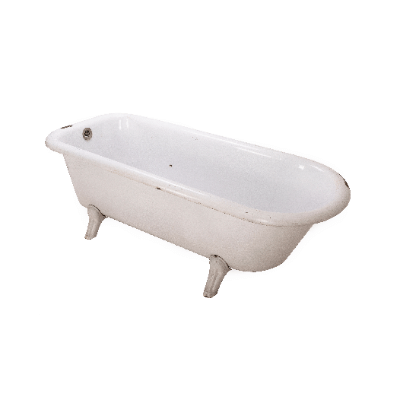What Is an Enamelled Bathtub?
 An enameled bathtub is a bathtub manufactured using a material called enamel.
An enameled bathtub is a bathtub manufactured using a material called enamel.
It is used not only for bathtubs but also for tableware and pots, and is characterized by its beauty and durability.
Enamel products themselves are made by baking a glassy substance (mainly silicon dioxide) onto the surface of a metal plate or metal casting at high temperatures. The use of metal makes enamel bathtubs more durable than bathtubs made of other materials. The glassy surface makes for a very beautiful bathtub.
Uses of Enamelled Bathtubs
Enamelled bathtubs are considered to be for high-end homes due to their high cost, but artificial marble bathtubs, which are less expensive than enamelled bathtubs, are also being used. Artificial marble is used as a substitute for marble not only in bathtubs but also in kitchens and washstands. After bathing, the bathtub can be kept clean by simply rinsing the surface off. It is becoming increasingly popular in recent years because of its excellent heat retention properties and resistance to mold growth.
Principle of Enamelled Bathtubs
Enamelled bathtubs and other enamelled products are made through the following processes:
1. Metal Shaping and Processing Engineering
Steel sheets are finished into a specified shape by sheet metal working or press working, etc., and then welded and formed into a product shape. In some cases, the product is cast from a mold instead of being pressed or otherwise processed.
2. Pretreatment Process
Here, oil and other contaminants adhering to the steel plate are removed. In addition, the steel plate is dipped in a nickel solution to change the surface of the steel plate to a state where glaze (silicon dioxide) can easily adhere to the surface. In some cases, steel sheets are dipped in sulfuric acid before being dipped in the nickel solution to roughen the surface and make it easier for the glaze to adhere to the steel sheet.
3. Glazing
Glaze is sprayed and applied to the pretreated steel plate. Glazes are made of glass powder mixed with silica stone, feldspar, metal oxides, borax, soda ash, etc. Many types are available depending on the color and characteristics of the product.
4. Yakiaki Project
After applying the glaze, allow it to dry thoroughly before firing. Firing is performed at 800 to 850 degrees Celsius for 5 to 10 minutes to complete the process. Depending on the product, the glazing and firing processes may be repeated multiple times.
Other Information About Enamelled Bathtubs
1. Life of an Enamelled Bathtub
Enamelled bathtubs have a lifespan of approximately 20 to 30 years. Deterioration is noticeable at this time, but if the enamelled bathtub is kept in hot water for a long time, the glaze on the surface of the bathtub tends to peel off and deteriorate in as early as 15 years or so.
2. Repair of Enamelled Bathtub
A common symptom of enamelled bathtub deterioration is cracking (cracking) or peeling of the glassy surface of the bathtub. In some cases, holes are formed and metal parts inside the bathtub are exposed. Water seeping into the interior can also cause the metal parts to rust.
Glass deterioration cannot be repaired by polishing alone because the original luster and texture of the enamel is lost. Painting for repair will cost 500 to 1500 USD.
If there are holes in the enamelled bathtub, the metal inside is often rusted, in which case replacement of the bathtub itself is recommended. In order to prevent soap scum and other stains from adhering to the bathtub, a clear coating treatment can be applied only in cases where the deterioration symptoms are not too severe. The cost is approximately 150 to 250 USD.
If you are considering DIY to reduce the cost of repair, you need to make a careful decision because of the difficulty of the work. If the metal inside the enamelled bathtub has rusted, not only will it recur if not completely removed, but the paint suitable for painting enamel is special, making it difficult to adhere to the repaired area and prone to peeling off. It is said that enamel painting is prone to construction defects, even by professional painters, so it is advisable to ask a professional who is good at painting from the beginning.